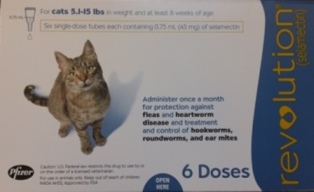
April 2018 – Tick Alert: It’s not just the deer tick anymore…
Lyme disease has been on the rise over the years spread by the tiny and well-known blacklegged tick (often referred to as the deer tick). However, another possibility of severe tick-borne illness is increasing due to an aggressive tick from the American southeast that has moved up the Atlantic Coast – the lone star tick.
Lone star ticks on the rise
The lone star tick is so named for the single white dot on the back of the female tick. The bad news is the lone star tick carries several pathogens including tularemia, southern tick-associates rash illness (STARI) and ehrlichiosis.
The research team from Rutgers University and the University of Tennessee performed a study comparing the human risk of ehrlichiosis infections to Lyme disease in Monmouth County, New Jersey, an area of high tick activity. Through coordination with the Monmouth County Mosquito Control tick identification service, the researchers analyzed the number and type of ticks submitted to the service for identification. Findings indicated that numbers of blacklegged ticks remain somewhat constant, while the incidence of the lone star tick continues to rise here in New Jersey.
Studies show that lone star ticks have large mouthparts and are more aggressive feeders than blacklegged ticks. They move faster than blacklegged ticks and will attach to both animals and people.
East Asian Tick the latest new arrival to New Jersey
In November 2017 we shared the news that an exotic East Asian Tick (also known as the longhorned tick or bush tick) was discovered on a farm in Hunterdon County on November 9 – another potential threat to humans, pets and livestock. Even though steps were immediately taken to eliminate the tick, it was just reported this week that the tick survived the New Jersey winter and migrated to Union County. Those just collected are now being tested for possible pathogens. Scientists will treat the affected areas with pesticide in hopes of eliminating the exotic ticks. We will try to keep you posted as new information develops.
Ehrlichiosis and other pathogens ticks carry
The term ehrlichiosis describes infection with one of the three currently known types of Ehrlichia bacteria. Two of these bacteria types are carried and primarily transmitted by the lone star tick. A third type is carried and transmitted by the blacklegged tick.
In addition, research reveals that ticks can carry multiple pathogens, and some of those, like the Powassan virus, have recently spread into blacklegged ticks creating the disturbing possibility of extremely serious coinfection (the condition of being infected by more than one pathogen at a time).
It only takes one tick bite for your unprotected pet to become infected by a pathogen. Not all pets show symptoms of infection within the first few weeks – some pets might not show any symptoms for months to years after an infected tick bite. If undiagnosed and untreated, your pet can become very sick. At times, tick-related diseases can even be fatal.

It is wise to have your dog tested for tick-borne diseases every year at their annual wellness. The earlier we find these hidden diseases, the easier and more effective the treatment. Some symptoms of tick borne disease can be weight loss, loss of appetite, lethargy, changes in gait, fever, joint pain and/or limping. If you suspect a tick-borne disease, call your veterinarian to set up a thorough exam as soon as possible.
Protect your pets and your family
Ticks thrive in or near wooded or grassy areas or on animals directly. The best way to prevent dogs from devastating tick diseases is to use a safe monthly preventative year round.

Did you know there are great, safe FDA approved oral preventatives now for dogs? Dogs love them because they are tasty treats. No more topicals needed. Oral preventatives are easier to administer on a monthly basis, and they are so much more effective and reliable than topical solutions. Studies show with topicals that approximately 30% of ticks that fall off looking dead can actually become active again and reattach and infect an unsuspecting human or pet family member. Oral preventatives have a much higher closer to 100 percentage chance of killing ticks and protecting everyone.
Discuss your oral preventative options with your veterinarian to be sure you are using the right product based on your pet’s age and weight. And remember what is prescribed for dogs is different for cats.
For example, one product we highly recommend for dogs based on its excellent results is Simparica which is effective against five different types of ticks for a full 35 days. Simparica is for use in dogs only, and for those that are at least 6 months of age and who weigh at least 2.8 lbs. Simparica is a chewable that not only kills ticks but also provides fast-acting flea protection. It can be offered by hand, in the food, or administered like other tablet medication. Care should be taken that the dog consumes the complete dose, and treated animals should be observed for a few minutes to ensure that part of the dose is not lost or refused.

Cats do not suffer from Lyme and other tick diseases, but they do suffer from many flea-related diseases. Revolution is our preferred topical for cats, protecting them against not only fleas and ticks, but also Heartworms and roundworms. It is the safest product for cats that is also FDA approved.

We always recommend talking with your family veterinarian before running out to buy a tick or flea repellant on your own. Grocery, big box and pet store products can contain harsh chemicals, and some are very dangerous for cats especially. Read labels carefully, and again, check with your family veterinarian for advice before administering. Your vet is still the best person to guide you with regard to your individual pet’s protection. He/she can also give you guidance with regard to goats, sheep and livestock under your care.
Recommended Reading:
Mosquito and tick-borne illnesses on the rise
Detecting ticks on your pet is crucial to prevent disease
Visit this Centers for Disease Control and Prevention website page to view images to help you identify the different types of ticks you may encounter.
Press Release: Exotic Tick Species Confirmed To Have Overwintered In New Jersey
Belle Mead Animal Hospital, Your Other Family Doctors
Handling Every Pet with Love Every Day!
LIKE us on Facebook and Follow us on Twitter @BMAH121, Pinterest and Google+ for news and pet wellness tips. We’re also on YouTube! Subscribe for updates! Tag us on Instagram!










